My first solo hike taught me a crucial lesson. I forgot warm layers and spent a chilly night in the mountains. This experience showed me how vital a hiking gear checklist is.
Good preparation can make your outdoor adventure amazing. A well-planned checklist ensures a safe and memorable journey through nature. It’s essential for both experienced backpackers and novice hikers.
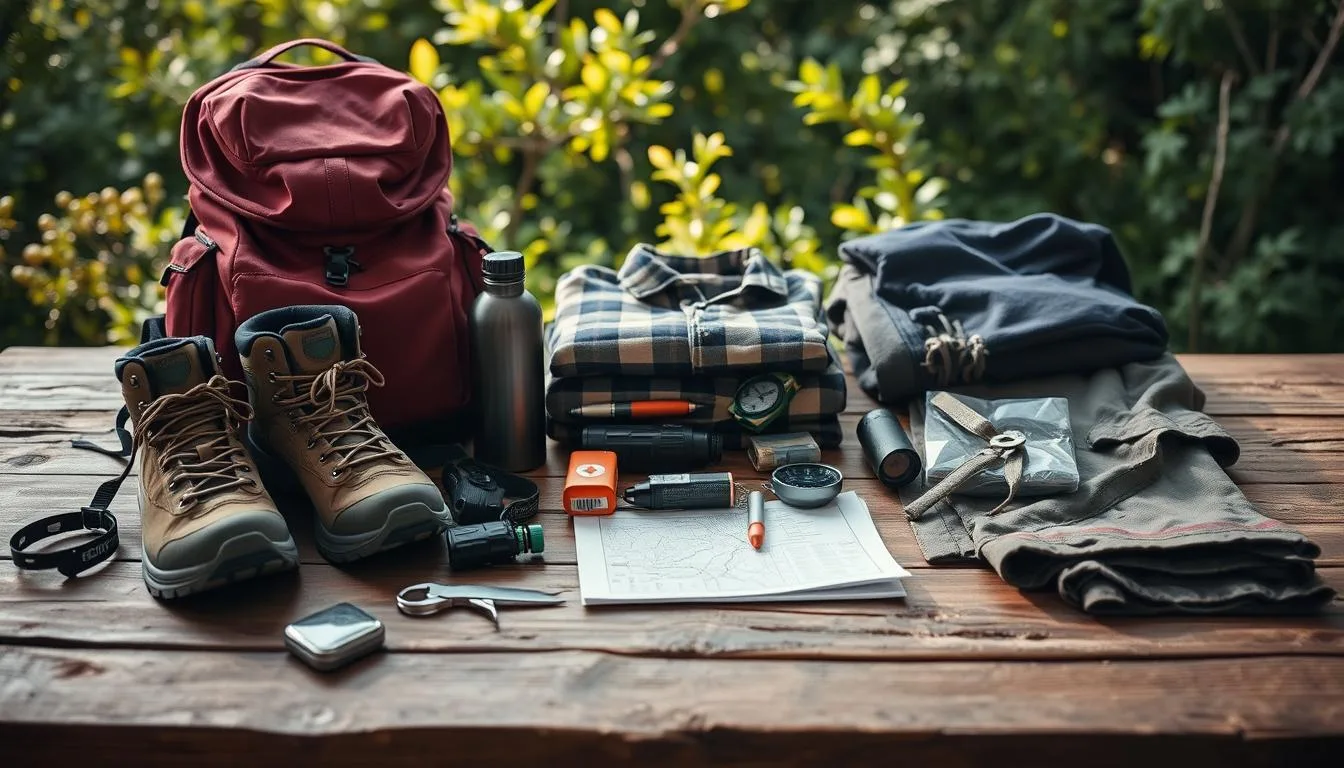
I’ve refined my backpacking essentials over the years of trekking. This guide shares my experiences to help you create the perfect hiking gear checklist. It covers what to keep and what to leave behind.
We’ll explore gear that enhances your hiking experience. This includes lightweight stoves and multi-functional backpacks. These items can make a big difference on the trail.
We’ll look at essentials like the Osprey Aura 65L backpack. It offers 60 liters of space and weighs only 3.5 pounds. This backpack balances capacity and weight perfectly.
Get ready to plan your next outdoor adventure. This guide will help you prepare for any wilderness challenge. You’ll have a complete checklist for your upcoming expedition.
Essential Hiking Gear Checklist
A trail gear inventory is vital for safe and fun hiking. This comprehensive checklist covers all essentials, from safety gear to comfort items. Use it to ensure you pack all necessary hiking equipment.
Backpack and Storage Solutions
Pick a backpack that suits your body and trip length. Day hikes need 20-30 liter packs, while longer trips require 50-70 liters. Use waterproof stuff sacks to organize gear in your backpack.
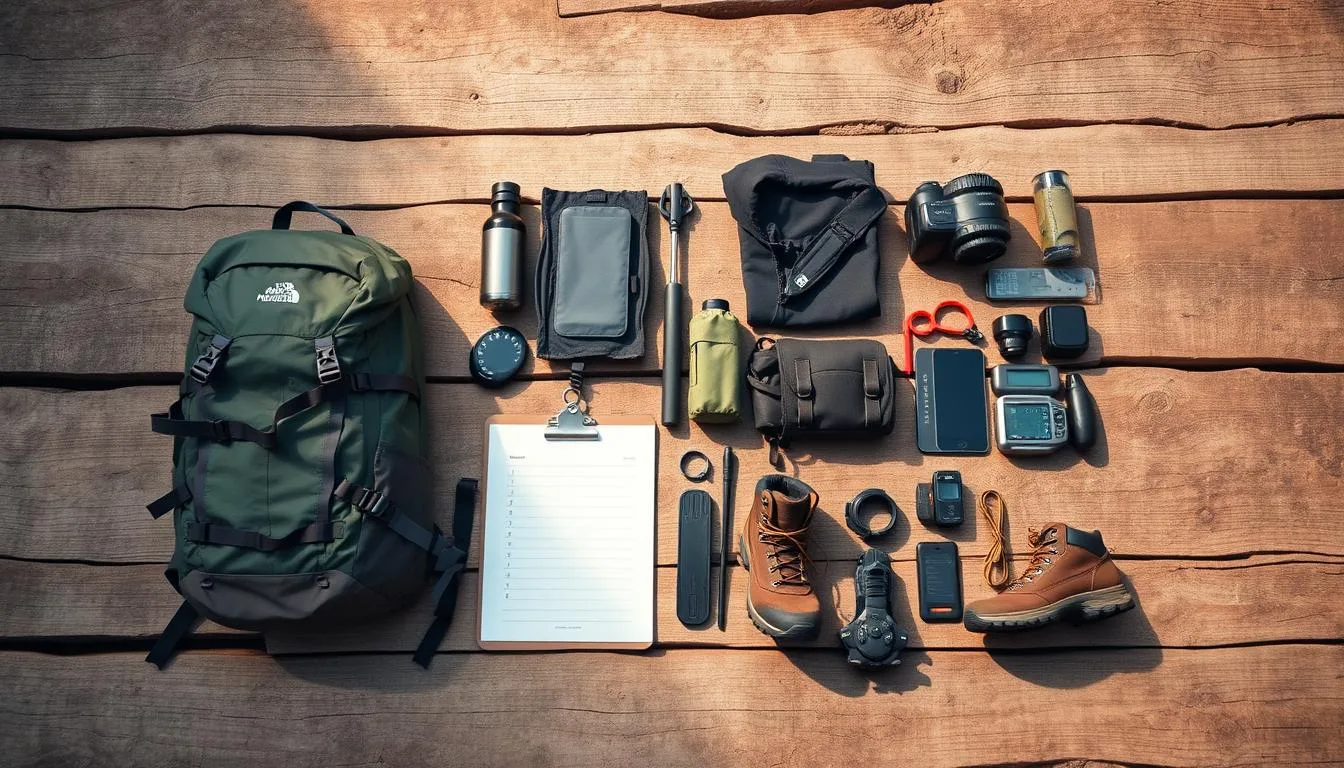
Navigation and Safety Equipment
Always bring proper navigation tools on trails. Pack a topographic map, compass, and GPS device. Learn to use them before your trip. A whistle and headlamp are crucial safety items.
Shelter and Sleep System
For overnight trips, bring a light tent, sleeping bag, and pad. Choose gear for expected weather conditions. Carry an emergency bivy sack, even on day hikes.
Hydration and Water Filtration
Carry a water bottle or hydration bladder. Bring a filter or purification tablets to refill from nature safely. Plan for 1 liter of water per 2 hours of hiking.
First Aid and Emergency Supplies
Pack a well-stocked first aid kit with your hiking gear. Include bandages, antiseptic wipes, pain relievers, and personal medications. Don’t forget a fire starter and emergency blanket.
This checklist is a starting point. Adjust your gear based on your specific trip needs and conditions.
Weather-Appropriate Hiking Attire
Packing the right clothes is vital for hiking. A good wilderness packing list ensures comfort and safety. Let’s explore the essential layers for your next adventure.
Base Layer Essentials
Your base layer acts as a second skin. Synthetic or merino wool fabrics are ideal choices. These materials wick moisture away, keeping you dry and comfortable.
Avoid cotton as it retains moisture. It loses insulation when wet, which can be dangerous.
Insulation and Mid-Layers
Mid-layers trap heat and provide warmth. Fleece, wool, or synthetic materials work great. For colder climates, pack a lightweight down jacket.
Down jackets are incredibly warm. They also compress easily, saving space in your pack.
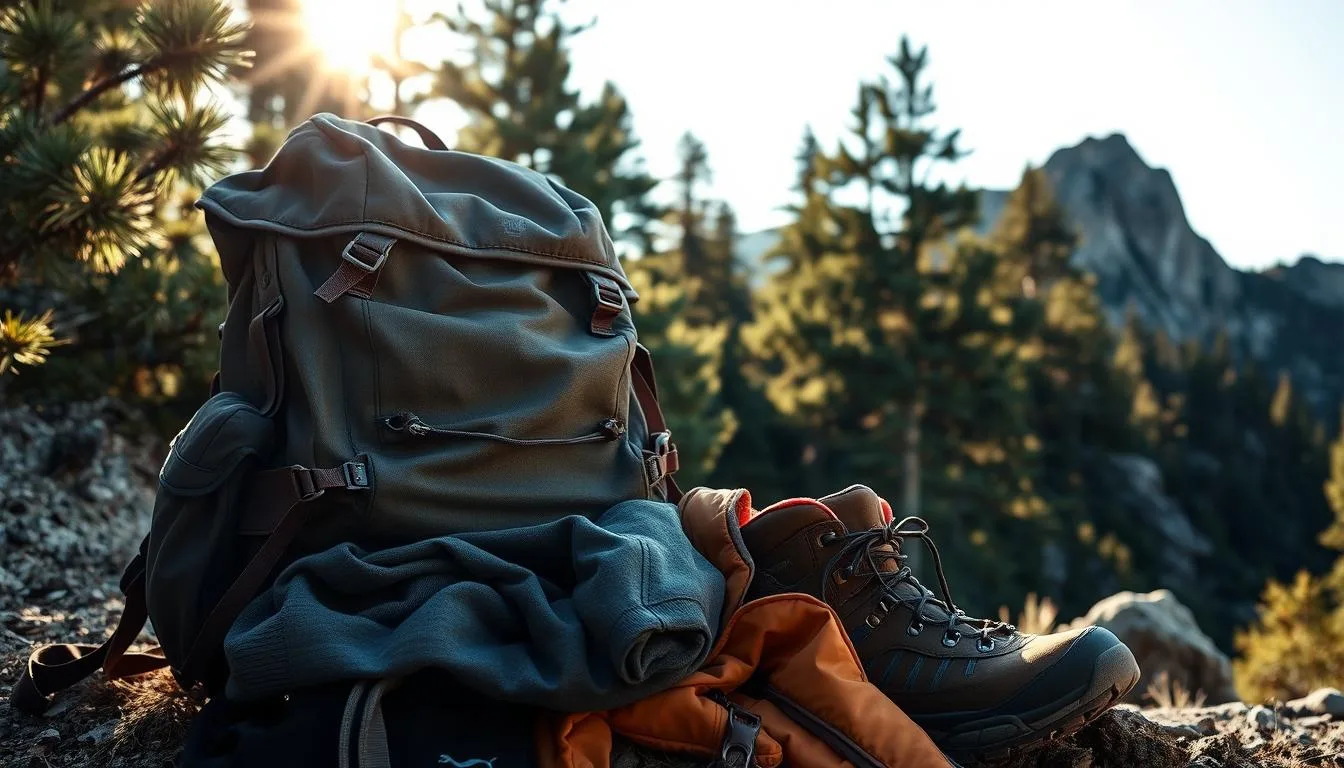
Outer Shell Protection
A good outer layer shields you from wind and rain. Gore-Tex jackets and pants are excellent choices. They’re waterproof yet breathable, perfect for changing weather.
Make sure your shell is packable. You’ll want to stow it away when the sun comes out.
Footwear and Sock Systems
Your feet carry you through your journey. Choose moisture-wicking socks made of merino wool or synthetic blends. For shoes, select waterproof hiking boots with good traction.
Remember to break in your boots before your big hike. This prevents blisters and discomfort on the trail.
Don’t forget accessories like hats, gloves, and sunglasses. They’re small but important additions to your packing list. With these layers, you’ll be ready for any trail.
Trail Nutrition and Cooking Equipment
Proper trail nutrition and cooking gear are vital for hiking success. This guide covers essential equipment for fueling your adventures and preparing meals outdoors.
Lightweight Stove and Fuel
A compact hiking stove is a must-have for your trek. The JetBoil or MSR Pocket Rocket are excellent choices. Remember to pack the correct fuel for your stove type.
Food Storage and Bear Protection
Bear canisters protect your food from wildlife. Always pack out all garbage to leave no trace. This includes food waste and packaging.
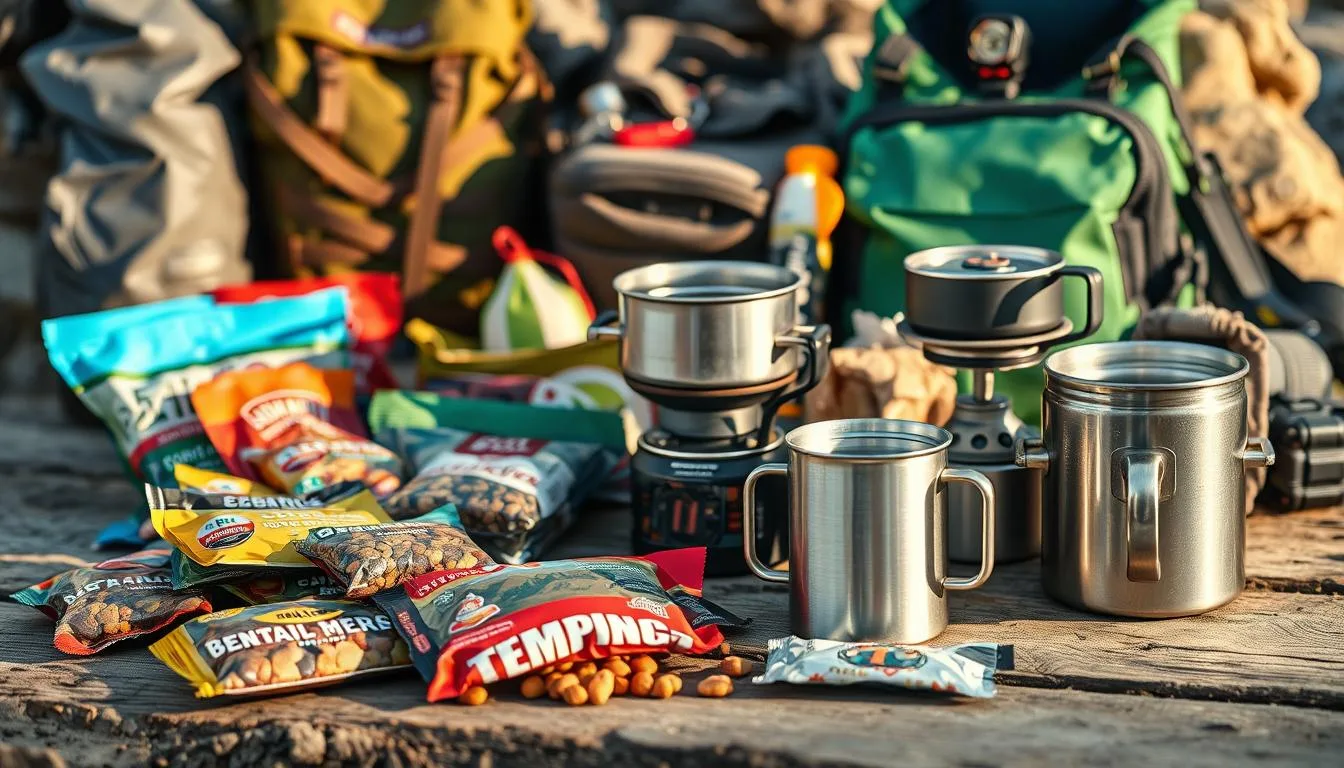
Cookware and Utensils
Titanium pots and sporks are lightweight and durable. A lightweight mug is great for drinks. These items cover all cooking and eating needs on the trail.
Water Treatment Options
The Sawyer Squeeze water filter is compact and effective. It ensures safe drinking water throughout your trek.
Dehydrated meals like spaghetti bolognaise or beef curry are perfect for dinner. Quick-cooking porridge or granola works well for breakfast. Sandwiches, wraps, or biscuits make easy lunches.
Energy-dense snacks keep you going between meals. Trail mix, jerky, and granola bars are great options. Balance weight, nutrition, and ease of preparation for successful trail meals.
Extended Trip Considerations
Longer outdoor adventures require careful planning and essential gear. A 50-60 liter backpack is perfect for extended trips. It fits all necessary items, including bear canisters for food storage.
Overnight Camping Gear
Multi-day hikes need a spacious tent and reliable sleeping bag. The sleeping bag should match expected temperatures. Your tent must withstand various weather conditions.
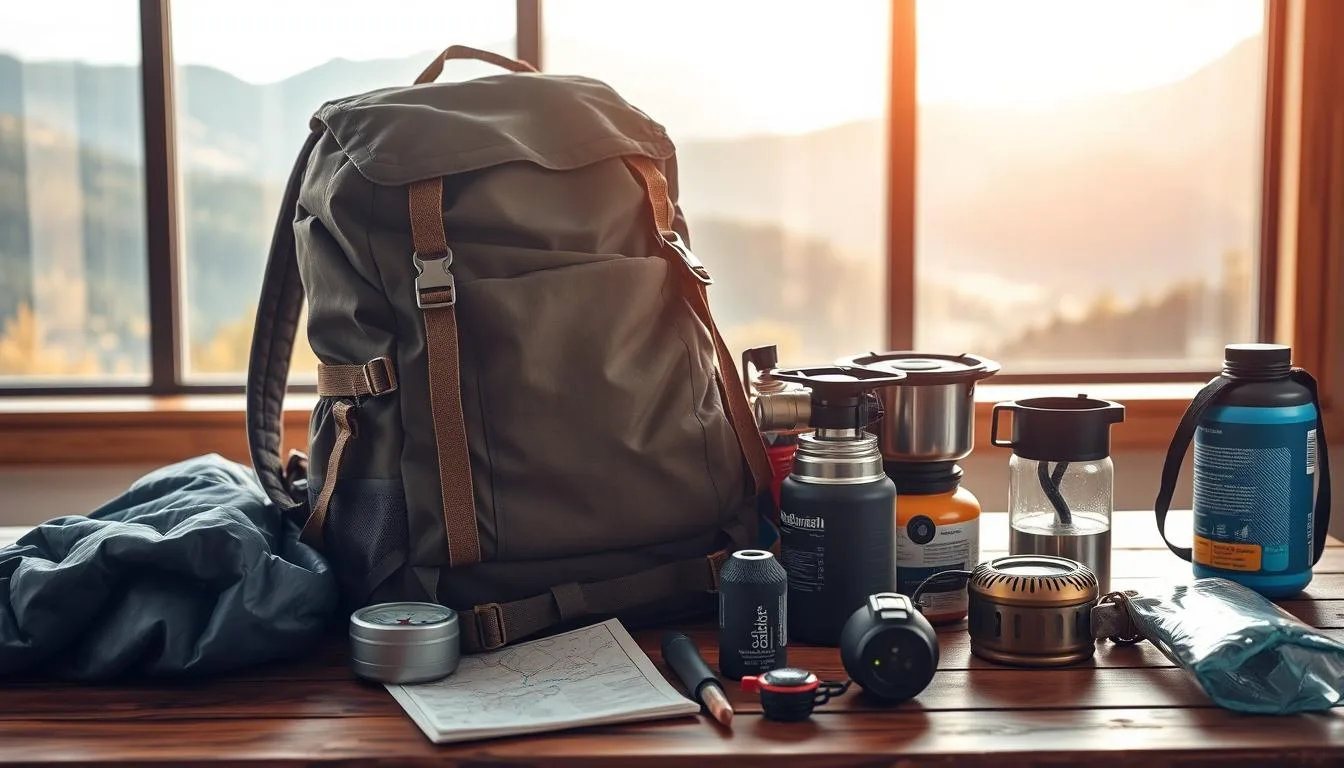
Personal Hygiene and Sanitation
Cleanliness is vital on long trips. Pack biodegradable soap, a small towel, and a portable shower. Follow Leave No Trace principles by carrying out all waste.
Gear Repair and Maintenance
Bring a multi-tool, duct tape, and spare parts for gear fixes. These items help solve issues during extended backcountry stays.
Comfort and Convenience Items
Some extras can greatly improve your experience. Consider a lightweight chair, inflatable pillow, and portable charger. The Platypus GravityWorks Water Filter System is great for group hydration.
- Dehydrated meals for lightweight nutrition
- Extra clothing layers for changing weather
- Comprehensive first aid kit with additional supplies
- Headlamp for nighttime navigation
- Electrolyte powders to replenish minerals
Thorough planning and the right gear ensure successful extended trips. Consider these elements carefully. You’ll be ready for your next multi-day backpacking adventure.
Conclusion
This hiking gear checklist covers essential items for your next adventure. It includes key items like backpacks and navigation tools. A well-planned gear inventory ensures safety and enjoyment on the trail.
Focus on lightweight, multipurpose items when assembling your gear. Choose a properly fitted backpack for your trip length. Comfortable hiking boots and a reliable tent are must-haves.
For sleeping, combine a lightweight air pad with a foam pad. Invest in a quality sleeping bag rated for expected temperatures. A compact stove system is essential for meals.
Include a headlamp with adjustable brightness for night navigation. Water bladders, dry bags, and trekking poles enhance organization and stability. These items complete your trail gear inventory.
This checklist ensures you’re well-prepared for outdoor adventures. The right gear keeps you safe and enhances hiking benefits. Enjoy your journey!

